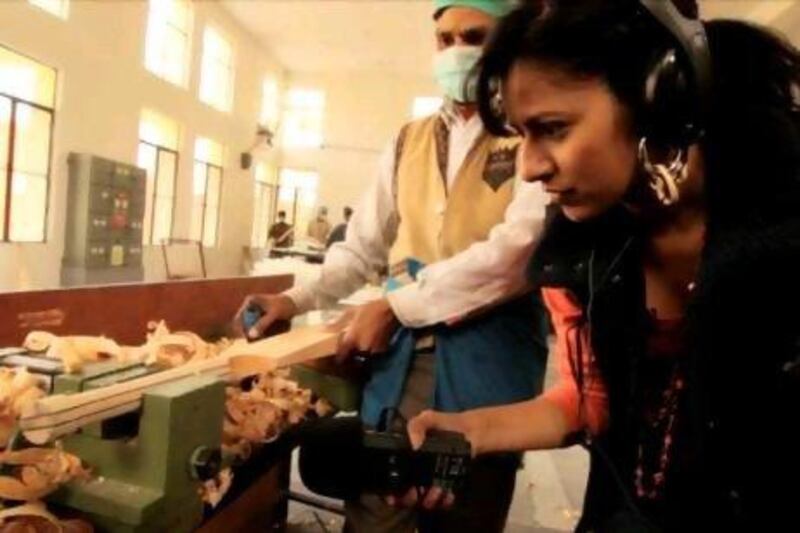It is the music of serendipity; the kind that cannot be composed in a recording studio or effortlessly crooned to rouse an auditorium to its feet. It takes the edginess of an unschooled voice, grabs the imperfection and strings it up in such a way that the blemish is a thing of beauty.
One song to be featured in the highly anticipated Hindi crime film Gangs of Wasseypur, which screened last month at the Cannes Film Festival and is due out later this month, was born out of such sudden fortune. It happened when Sneha Khanwalkar, Bollywood's only female composer, was travelling through the boondocks of India on her mission to bring the country's quirky, quintessential and vastly ignored local music to the mainstream.
"We were in the midst of the Musahar community, one of India's most unprivileged and poorest groups, commonly known as the rat-catchers," she says. "They are so poor that they are known to eat rats in tough times. Our crew was done for the day and I was walking around with just a hand recorder. There were a lot of kids crowding me, as they do in remote locations. The recorder was on and we were jamming. In a manner of humouring them, I asked them to sing. And that half-hour of recording made for a song in the film. I had to do nothing else. That recording became golden for me, and when I reheard it back in the city, I knew I got gold. You can't get a kid in the city to sound like that - that voice with mucous in the nose, singing poem in the Bihari accent. It was goosebumpish."
Khanwalkar, a 28-year-old phonetics obsessive (who impressed her third grade teacher and classmates by describing the sound of a gunshot in older Hindi movies as "dhichkyaaoon" rather than "boom"), has no formal musical training. Instead she studied animation and art direction, amassing skills on her mission to collect, document and compose music from the sounds of India that many would dismiss as mere noise.
Her technique, which has been captured for India's audience in the popular new show MTV Sound Trippin, considers all possible sources. Whether it is the rhythm of a farm tractor in the agricultural state of Punjab, the lilting sound of temple bells on the banks of Ganga, the gentle lapping of the great River Brahmaputra on the shores of a disappearing island or the crunch of coconut shells drying on the idyllic Goan beaches, Khanwalkar doesn't consider anything wasteful. Even a cough is music to her ears.
"Each sound has a character," she says. "A peaceful lake can evoke something and it could become a bed for a song. Or harsh rain or a droplet sound - it could say a lot of things. Each sound can be used within its character."
In the show, Khanwalkar is armed with a hand recorder and massive headphones as she scouts for anything and everything that conveys Indian music within its local context and flavour, but in a way that appeals to the MTV-watching generation. Since premiering on April 14, MTV Sound Trippin (motto: "journey from sound to song") has crisscrossed India from Assam to Karnataka to Goa, in no particular order. Khanwalkar spends time recording with villagers and tribes, exploring their old and unusual musical instruments and the sounds of their daily life. Each episode ends with a fully composed song pulled from part of her journey.
"We didn't want to be completely self-indulgent," she says. "We wanted a happy song but without alienating any kind of sound, from grunting to spoken word, to singers to musicians.
"Any place in India has something or other that differentiates it. Each place has music. It wasn't difficult to choose where to go."
The most moving experience involved the Siddhis, a small tribe unaware of their connection to an African community that Khanwalkar knew of and respected.
"They were alienated within India because they look different," she says. "They have adopted religions - Hindus or Muslims or Christians - here but they speak in Marathi and Kannada and wear saris. But they don't even know how good their music is because no one has told them. They wouldn't have known if we hadn't gone there, either. That was a bit heartbreaking because they are between two worlds."
Khanwalkar was also between two worlds until Dibakar Banerjee, one of India's most experimental and acclaimed young directors, gave her her first break in Bollywood. His 2008 film Oye Lucky! Lucky Oye! placed Khanwalkar firmly in the middle of a changing Hindi cinema landscape. She first visited Punjab while researching the film on a two-week trip that ended up stretching into 45 days. In the end, the voices of an 11-year-old boy and a 75-year-old man made it to the official soundtrack, singing Tu Raja Ki Raj Dulari and Jugni, respectively, shaping Khanwalkar's style and boosting her career prospects in the process.
"I met a lot of singers and indulged myself, developed a sense of agenda, extracted from people," she says. "I fit into this so comfortably that very soon I made songs only with sound and no instruments at all. I composed a couple of songs for Love, Sex aur Dhokha and Wasseypur in gibberish and I felt absolutely comfortable doing that."
Although one could expect a show such as MTV Sound Trippin to prompt some regionalism in a country as diverse and sometimes divided as India, audience reaction so far has been positive.
For Khanwalkar, sound remains both a medium of observation and introduction.
"When I put my enormous headphones on, really old people or kids have awesome reactions, mostly a lot of laughter. But music levels everything. As soon as they are off guard, they are at their most genuine."
To watch footage and listen to music from MTV Sound Trippin, go to mtv.in.com/soundtrippin





